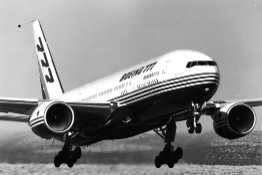 Return to
Return to
Aviation Answer-Man
Gateway
 Return to
Return toEight Great Aircraft
starting page
.
Chapter 1
The
Douglas DC-3
Copyright 2000, 2001, 2002, 2010, 2012 by Richard Harris
All Rights Reserved
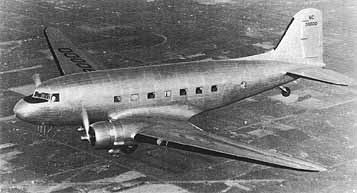
The Douglas DC-3 / C-47
was
"The Most Important Aircraft of the Century."
The DC-3 was THE pivotal aircraft in making mass transportation by air a reality. Nothing before it had accomplished that. Most aviation historians agree that the DC-3 is the most important aircraft in the history of the world.
In the 1930s, commercial flying was exotic, expensive, dangerous and uncomfortable for passengers -- until the DC-3 came along, with its sturdy, stable bulk, excellent performance, civilized flying characteristics, rugged dependability, and economical high-capacity seating-- a practical combination far surpassing any airplane that had ever come before.
|
The DC-3 evolved from the smaller DC-1 and DC-2, created in 1934 by Douglas Aircraft of Santa Monica, California, to accommodate a specification from Transcontinental and Western Airways (later "TWA"). Though outwardly similar to the later DC-3, the DC-1 and DC-2 had narrower fuselages, with only two-abreast seating. Though the prototype DC-1 -- and resulting DC-2 airliner -- seated more than most of the competition, they still only carried about 14-15 people. Nevertheless, the DC-2 was an excellent airliner (shown at left, top), pushing forward the design standards of the time, with lightweight (but stout) hollow-shell, all-aluminum structures, and a clean, unbraced "cantilever" wing. And it was powered by the new, reliable 710-horsepower Wright "Cyclone" radial engines. The DC-2 also had "flaps" on the trailing edges of the wings, which extended downwards for extra lift and drag at low speeds -- making slow landings and quick stops on short airstrips safely possible, and enabling quicker takeoffs at slower speeds, from shorter airstrips. Yet, aloft, with flaps and landing gear retracted, the aerodynamically "clean" DC-2 was just about the fastest airliner in the sky, cruising at around 185 mph, ranging up to 1,200 miles. The quick, roomy, efficient and flexible DC-2 airliner was a fairly quick hit with the airlines. However, in 1935, when American Airways (later "American Airlines") ordered a "sleeper" version, with sleeping berths for long flights, Douglas had to build a wider, bulkier plane. With great care, under the guiding hand of Donald Douglas and engineers Arthur Raymond and "Dutch" Kindleberger, the company created a wide-but-streamlined, cigar-shaped fuselage tube.
While most previous major airliners had been boxy (with straight vertical walls and horizontal tops and bottoms), the DC-3's cross-section was a near-circle, fairly evenly distributing stresses around the fuselage, and expanding its width and height.
At the same time, the smooth, round shape's greater aerodynamic qualities minimized the drag effects of greater size, and -- combined with powerful new Wright Cyclone engines -- the roomy, 180-mile-per-hour Douglas Sleeper Transport ("DST") was born.
Designer Jack Northrop added another advantage: the wings used a new "multi-cellular, stressed-skin" construction, where the traditional main support beams (wing spars) and cross-members (ribs) were replaced with dozens of metal boxes riveted together like a honeycomb, providing redundant strength not dependent on any one member.
MAKING PASSENGER AIRLINES PROFITABLE But it quickly became clear that the flying-sleeper business was not what the airlines had hoped for. Too few people could be carried to make a "sleeper" flight profitable, and too few people needed to travel so far, by air, that it would require sleeping in flight. But Douglas clearly had a fine new airplane on its hands. By simply replacing the sleeping berths with seats, the 21-seat Douglas DC-3 was born -- requiring little or no more power (and fuel) than the 14-berth sleeper, and not much more than was required for the 14-seat DC-2. The 50% growth in passenger capacity, without a corresponding growth in operating costs, revolutionized the profitability of airliners, and commercial aviation.
The cost of the slow, expensive, flight was shared by a measly dozen or so passengers (in two-abreast seating) -- making tickets so expensive that they were practical only for the rich.
COMFORT ALOFT Further, the DC-3 introduced 5 important comfort advantages to airline flying:
 -- drawn from inlets ahead of the engine exhausts, and blown smoothly through the cabin.
-- drawn from inlets ahead of the engine exhausts, and blown smoothly through the cabin.
No longer were suffocating passengers required to open a side window for ventilation, and consequently inhaling engine fumes, as was customary on older airliners. The closed-window ventilation of the DC-3 also eliminated the chaotic blasts of wind and propwash from open windows, and shielded passengers from the deafening noise of wind and engines.
Before the DC-3, riding an airliner was much like riding in an old-fashioned stagecoach. After the DC-3, it was more like riding in a comfortable, modern bus.
But most decisive of all, was the radical change in airline economics with the introduction of the DC-3. With the DC-3 hauling nearly TWO-dozen passengers (in three-abreast seating) to pay for the ride, the cost-per-passenger was much lower -- bringing ticket prices within reach of the typical upper-middle-class North American or European citizen. Prior airliners could only make money if they carried valuable lightweight cargo, such as mail. The DC-3 was the first successful airliner to truly be profitable at hauling only passengers. Other characteristics of the DC-3 improved its economics:
Between the DC-3's introduction in 1935, and America's entry into the Second World War at the end of 1941, in just 6 years, there was a 600% growth in the number of passenger miles flown across the United States. Those passenger miles were flown mostly on DC-3's. It would be years before any competitor could match the DC-3's virtues for anywhere nearly the same purchase and operating costs. For a decade and a half, the DC-3 remained the pre-eminent American airliner.
But the DC-3 was more than a powerhouse in the American airline industry. With virtues that so completely eclipsed all other airliners, the DC-3 quickly spread throughout the WORLD.
By late 1939,
AIR CARGO BECOMES PRACTICAL As DC-3's began to replace older airliners, the older planes' passenger capacity became useful as cargo capacity, and air cargo activity became more practical and widespread. And, along with the development of the DC-3 as an airliner, there was a corresponding (though lesser) development in the DC-3 as a cargo-carrying airplane.
At first, cargo was a small percentage of the load carried by DC-3's, slowed somewhat by the ready availability of older airliners for that purpose -- airliners no longer carrying passengers (due to competition from the DC-3). But airlines soon learned that the vast load-carrying capability of the DC-3 was not limited to people and their personal luggage. Soon, small (but profitable) bits of air cargo were carried along with passengers.
These two new venues for air cargo -- idle old airliners (made available by their replacement by DC-3s), and fast, efficient new DC-3's -- made it increasingly possible for vital cargo to reach distant destinations in a fraction of time that ground transportation allowed. (For a clear depiction of DC-3 / C-47 cargo capabilities and configuration, on the website of a current British DC-3 cargo operator, click here. Numbers are metric; approximate conversions: 1 m(meter) = 3.3 ft.; 3 km(kilometer) = 2 miles) The combination of rapid passenger travel and rapid movement of vital cargo helped the acceleration of critical segments of the American and European economies, as they dragged themselves out of the Great Depression, and prepared for the looming possibility of war. MILITARY AIRLIFT BECOMES A POWERFUL WEAPON
Dressed in military livery for World War II, the DC-3 became the military "C-47 Skytrain," "C-53 Skytrooper," "R4D," or "Dakota". (Other variants included C-48, C-49, C-50, C-51, C-52, and C-117). The addition of bigger engines (up to 1,200 hp), stronger flooring, and large cargo doors greatly enhanced the military utility of this big, rugged transport -- the "Gooney Bird" as it was affectionately nicknamed by the troops.
With its great speed, range, ruggedness, carrying capacity, and sheer numbers, the C-47 radically changed the ability of armies to move quickly, and their ability to readily maintain and support far-flung operations. America and her British Empire allies used thousands of C-47's to quickly transport troops, weapons, munitions, small vehicles, essential equipment and supplies to forward areas.
The C-47, with military seating, could officially haul 32 people, or 28 combat-equipped troops,
The same was true of its cargo hauling. The C-47 was designed for loads of up to 6,000 pounds -- internally and on cargo hooks under the belly. But those load limits, too, were often ignored -- succesfully. Its huge cargo door could (and did) accept massive items, including an entire Jeep or howitzer. With the plane's ability to land and take off from rough fields, less than a half-mile long, it could quickly deliver combat men and material close to the front lines, providing great speed and flexibility to ground combat units. Where there was no place to land, but supplies and men were urgently needed, they were delivered by parachute.
With these capabilities, swarms of C-47s deployed regiments, battalions, even whole divisions with thousands of troops into critical combat targets. The C-47 gave exceptional airborne speed and mobility to vast numbers of ground troops, firmly establishing the modern concept of "airborne" warfare. Whether delivering cargo or people -- by landing, or glider, or para-drop -- the abundant, capable C-47 accelerated the pace of ground warfare, establishing aircraft as an essential tool of GROUND warfare.
Certainly the C-47 was exceptional by virtue of its sheer numbers: over 10,000 were built for the war, and hundreds of civilian DC-3's were pressed into military service, as well. The capabilities of the C-47 caused allied military forces to develop fundamentally new tactics and strategies for conducting war, accelerating the pace of victory. The Soviet Union (Russia and its neighbors) also used DC-3's -- and even began their modern air transport manufacturing by building about 2,000 copies of the DC-3 (under license) as the Lisonov Li-2 -- for the war on Germany. Ironically, the Allies' eastern enemy, the Japanese, even used their own copy of the DC-3's predecessor -- the DC-2 -- having built over 400 of them as the Nakajima Ki-34 and Showa L2D.
However assessed, the DC-3 was the most important force ever in the development of military airlift and airborne ground forces.
Although the German Junkers Ju-52/3m tri-motor (right) was a key precursor of airlift's influence, the Douglas C-47 -- with about double the Ju-52's capability, and better in virtually ever other respect -- outperformed and outlived it, doing far more to shape the role of military airlift, and future military transport aviation. The DC-3 would be a superior military tool in World War II, and would soldier on to be a major player in military forces throughout the world -- clear up until the present day. (It was a major U.S. weapon as recently as the Vietnam War, where it served as a versatile transport, but also pioneered the development of the orbiting-attack heavy-gunship -- with devastating effect. It continued in limited U.S. military service until the early 1980s, and reportedly still remains in the service of some small nations' military forces around the world.). POSTWAR COMMERCIAL AVIATION BOOM
In the 1950's, after its dominance in the major airlines had been eclipsed by larger airliners (particularly newer Douglas airliners), the DC-3 formed the backbone of a whole new class of airlines:
At the same time -- having shown themselves capable of carrying anything you could stuff in the door -- the war-surplus Gooney Birds became increasingly valuable as cargo-haulers, and accelerated the development of air-cargo transportation. This further enhanced the booming American and European economies of the 1950's and 1960's. BRINGING THE POWER OF AVIATION TO THE WORLD Echoing the growth of American and European modern airlines, the durable, surplus DC-3's -- available cheaply in vast numbers -- found their way into every corner of the world, bringing the benefits of air transport to places long-isolated from the rest of the world.
The DC-3 made it possible to put almost anyone (or anything) anywhere, anytime. Only the helicopter would develop a more complete reach -- but the DC-3 would continue to carry far greater loads, much farther and faster. Still not retired, 75 years after the DC-3's birth -- three-quarters of a century -- many of them are still in regular use around the world -- despite the fact that even the "newest" ones are at least 65 years old. In the United States, alone, in 2002, the Federal Aviation Administration showed over 600 DC-3's still registered as active (UPDATE: 8 years later, that still held true! As recently as July, 2010, in the DC-3's 75th Anniversary year, there were 610 of the DC-3 and its military variants still registered with the FAA. At least 30 gathered for a grand arrival at "EAA AirVenture", the world's largest annual airshow, in Oshkosh, Wisconsin, USA). Dozens (possibly hundreds) more -- too useful to scrap -- operate around the world, today.
Some are refitted with turboprop engines, and others with the latest electronics.
SETTING THE SHAPE OF THINGS TO COME
To put it more simply, before the DC-3, most airplanes were built like oil derricks, laid on their side, and wrapped in fabric or corrugated tin skins. The DC-3 established, firmly, the virtue of designing airplanes like light-but-stout, round, tin cans -- the basic aerodynamic, lightweight, shape of airplanes today.
Though controversial at first, this design soon proved sound. A documentary film about the DC-3, on its 50th anniversary in 1985, reported that not one DC-3 had ever crashed due to an in-flight structural failure. The "Gooney" also furthered other key technological advancements. It clarified he value of drag-reduction through:
It further established the merit of:
Unlike most previous airliners, the DC-3 (like the DC-2 and Boeing's 247 before it), could easily climb away from the airfield on one engine -- providing a critical element of safety on takeoff (the phase of flight when catastrophic engine-failure is most likely). The addition of engine turbo-superchargers -- providing additional power in the thin air at high altitudes -- was icing on the DC-3 cake. And to deal with icing on the wings, the DC-3 introduced de-icing boots on wings and tail -- a critical life-saving advance that would make true all-weather flying safe and practical, greatly expanding the capability and reliability of airliners, and all airplanes. This combination of performance and utility enhancements Boeing 247 (shown at left, graph below).However, the faster (180mph), longer-range (1,000-2,000 miles), heavier-hauling, 21-24 passenger DC-3 made these features far more profitable and persuasive -- ultimately revolutionizing airliners. A final major advance of airliner aviation, implicitly pioneered by the DC-3, was the use of round, hollow-shell fuselages, rather than rectangular or internally-braced ones -- an essential design transition necessary to develop pressurized airliner cabins, permitting flights in the thin air at higher altitudes (above 10,000 feet -- over turbulence, foul weather and mountains) without oxygen masks. Although the DC-3 was never pressurized, its establishment of circular cabins as "normal" firmly established a basic airliner design concept that lent itself readily to pressurization. By comparison, boxy rectangular cabins were not well-suited to pressurization, because of the uneven distribution of air pressure in early pressurized cabins -- easily exceeding 2 pounds of pressure per square inch, pressing out against every square inch of the cabin wall. But circular cabins (like round balloons) were a natural shape for readily containing pressurized air.
Without pressurization, jet airliners would not have been practical, because they only operate efficiently at very high altitudes, where the air is to thin for people to breathe. But the DC-3 rounded-shell fuselage -- a design concept now almost universal in commercial airliners -- has made such shapes, and resulting application of pressurization, quite practical, along with making jet airliners a practical reality. As if its own contribution to advancing aerospace technology were not enough, the DC-3 was used, as recently as 1984, by NASA -- as a research vehicle for the space program. Among its many tasks: serve as the "glider towplane" for the first wing-less "lifting body" aircraft -- the prototype for what ultimately would become the Space Shuttle.
Over 10,000 DC-3's/C-47's were built in the 1930's and 1940's, and dozens (probably hundreds) are still in civilian or military service around the world, today. Three-quarters of a century since its inception, with all DC-3s now at least 6 decades old, many are still flying, working airplanes, continuing the active influence of the DC-3 design, even today. Perhaps the most talked-about "Holy Grail" in airplane design, for over half a century, has been the fantasy -- never quite realized -- of "a DC-3 replacement."
No other airplane in history has had so broad and lasting an effect on air transportation. WHY THIS AIRCRAFT STANDS OUT FROM ITS "PEERS" While many other planes have been important, few (if any) others had nearly so pivotal an impact on aviation or on history as the DC-3. The Douglas DC-3 is the foremost of the eight aircraft which are the "indispensable" aircraft of history -- aircraft with no significant conceivable substitute available at their juncture in history -- which changed history by their presence. In fact, the DC-3 is arguably the "ultimate" airplane -- more important in every way to civilian aviation than any other aircraft that ever flew, and one of the very most important military aircraft of all time.
In its "C-47" military version, and other military variants, the DC-3 is clearly the most important aircraft in the history of military airlift; no other military transport plane (with the remote possible exception of
The Boeing 247, a fast and advanced airliner for its day (which introduced many modern innovations to airliners), was still no match for the much-bigger, generally superior DC-3. And much-smaller, much-slower, old-fashioned airliners -- like the Ford TriMotor and the Fokker TriMotor (shown above, right), and big biplane-airliners like the Boeing Model 80 and Curtiss Condor -- couldn't hold a candle to it; they couldn't even successfully compete with trains and buses, let alone lead a great advance in air transportation.
And it took the DC-3's military versions to make military airlift practical and powerful -- making possible the rapid mobility of vast armies across great distances, and ensuring their sustainability far from home. And it took the DC-3 to make air cargo truly cost-effective -- accelerating and reinforcing critical aspects of industrial economies -- while connecting the resources of the world through fast, efficient, capable, reliable transportation around the globe. In short: that made air transportation a powerful and decisive force in the modern world.
For more information, try these sources:
STRICTLY MILITARY:
|
 Return to
Return toEight Great Aircraft
starting page
 Return to
Return to
Aviation Answer-Man
Gateway

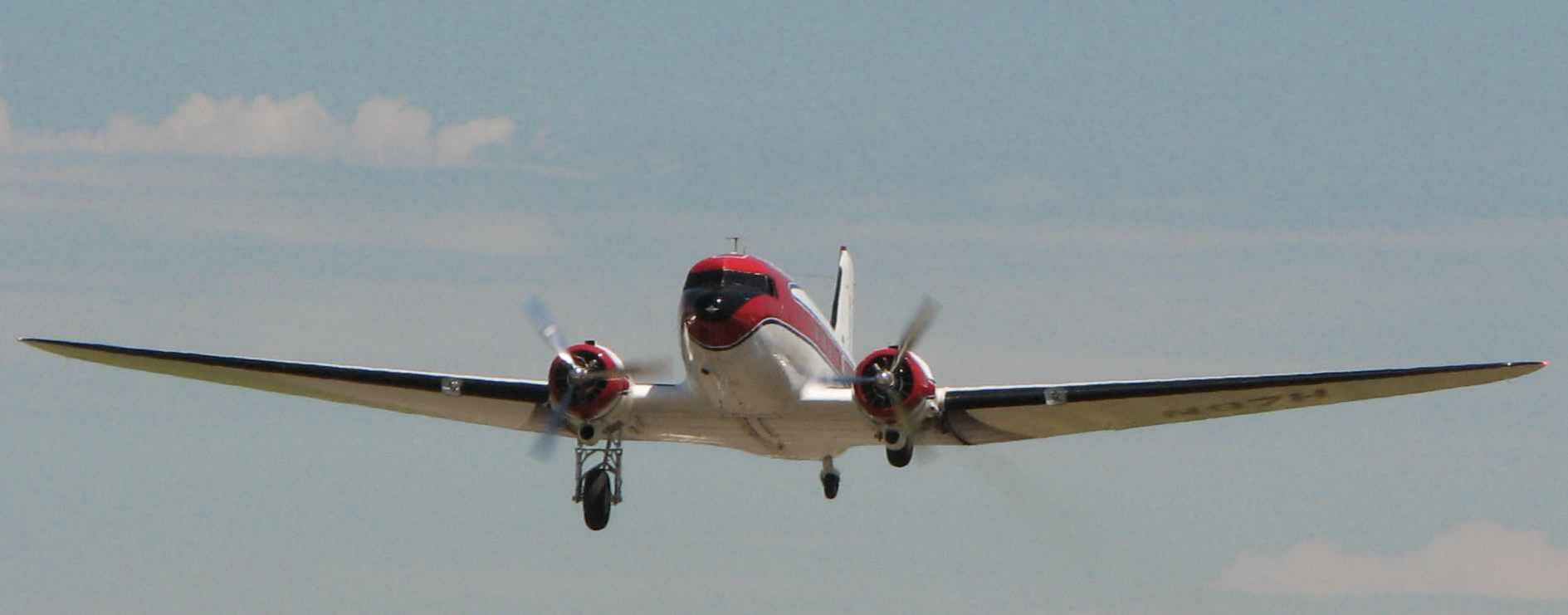
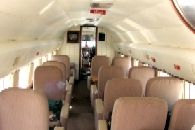 while creating a wider middle -- permitting three-abreast seating (typically 7-8 rows, 21-24 passengers) -- with little additional weight, wing or horsepower required.
while creating a wider middle -- permitting three-abreast seating (typically 7-8 rows, 21-24 passengers) -- with little additional weight, wing or horsepower required.

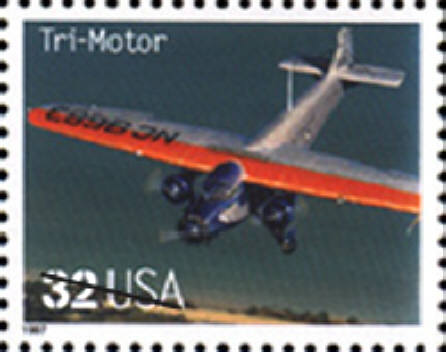 Before the DC-3, airlines hardly existed, and almost no one ever flew. Rickety, noisy, flying rattle-traps like the Ford and Fokker tri-motors, and lumbering biplane-airliners by Boeing and Curtiss, trundled their awkward, bulky shapes through the sky at 90-120 miles per hour -- sometimes struggling to make headway against strong winds, which the trains on the ground could swiftly blast through.
Before the DC-3, airlines hardly existed, and almost no one ever flew. Rickety, noisy, flying rattle-traps like the Ford and Fokker tri-motors, and lumbering biplane-airliners by Boeing and Curtiss, trundled their awkward, bulky shapes through the sky at 90-120 miles per hour -- sometimes struggling to make headway against strong winds, which the trains on the ground could swiftly blast through.
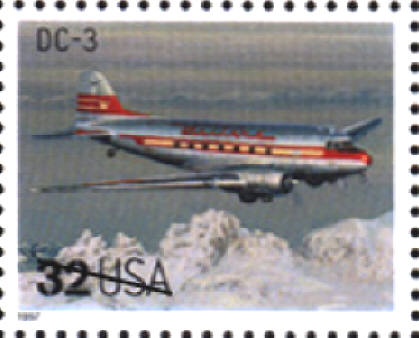 By comparison, the DC-3's smooth, streamlined shape and powerful engines enabled it to slip through the sky gracefully and efficiently, cruising at nearly 200 miles per hour (though 160-180 mph was more common). When bucking strong headwinds aloft -- particularly when heading west -- it was not uncommon for DC-3s to arrive in less than half the time of older airliners.
By comparison, the DC-3's smooth, streamlined shape and powerful engines enabled it to slip through the sky gracefully and efficiently, cruising at nearly 200 miles per hour (though 160-180 mph was more common). When bucking strong headwinds aloft -- particularly when heading west -- it was not uncommon for DC-3s to arrive in less than half the time of older airliners.

 ECONOMICS: AFFORDABLE FLIGHT
ECONOMICS: AFFORDABLE FLIGHT
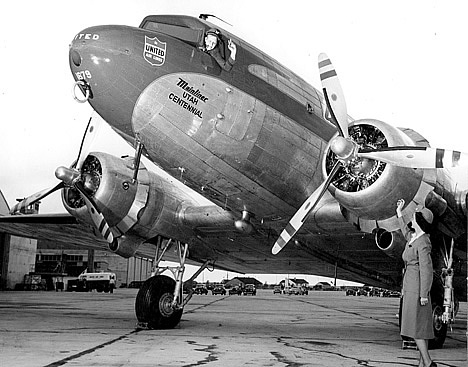
 With the arrival of the DC-3, the airline industry underwent an explosive growth and transformation -- due directly to the radical, decisive new combination of key virtues found together only in the DC-3.
With the arrival of the DC-3, the airline industry underwent an explosive growth and transformation -- due directly to the radical, decisive new combination of key virtues found together only in the DC-3.


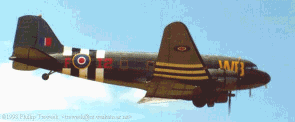 For the same reasons, the DC-3 has been a decisive instrument of war.
For the same reasons, the DC-3 has been a decisive instrument of war.
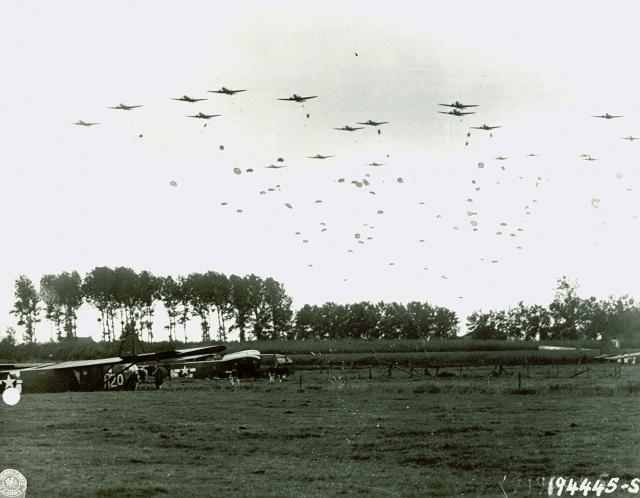
 or evacuate 21 wounded soldiers on stretchers. But in the actual wartime emergencies, these limits were often ignored, and the plane sometimes carried up to twice its official load.
or evacuate 21 wounded soldiers on stretchers. But in the actual wartime emergencies, these limits were often ignored, and the plane sometimes carried up to twice its official load.
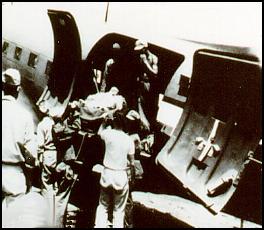 "Gooney Birds" often landed or parachuted troops into areas behind enemy lines (massive "paradrop" shown above, left), and evacuated the wounded to distant Allied hospitals (right). Some towed massive "invasion gliders" that held up to a dozen or more troops, or jeeps, howitzers and ammunition -- releasing the gliders to land behind enemy lines.
"Gooney Birds" often landed or parachuted troops into areas behind enemy lines (massive "paradrop" shown above, left), and evacuated the wounded to distant Allied hospitals (right). Some towed massive "invasion gliders" that held up to a dozen or more troops, or jeeps, howitzers and ammunition -- releasing the gliders to land behind enemy lines.
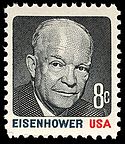 General Dwight D. Eisenhower, Supreme Allied Commander in Europe during World War II, in his memoirs, praised the C-47 as a critical tool of the war. He credited the C-47 as one of a half-dozen "pieces of equipment that most senior officers came to regard as among the most vital to our success in Africa and Europe." (Crusade in Europe, by Dwight D. Eisenhower, pp.163-164.)
General Dwight D. Eisenhower, Supreme Allied Commander in Europe during World War II, in his memoirs, praised the C-47 as a critical tool of the war. He credited the C-47 as one of a half-dozen "pieces of equipment that most senior officers came to regard as among the most vital to our success in Africa and Europe." (Crusade in Europe, by Dwight D. Eisenhower, pp.163-164.)
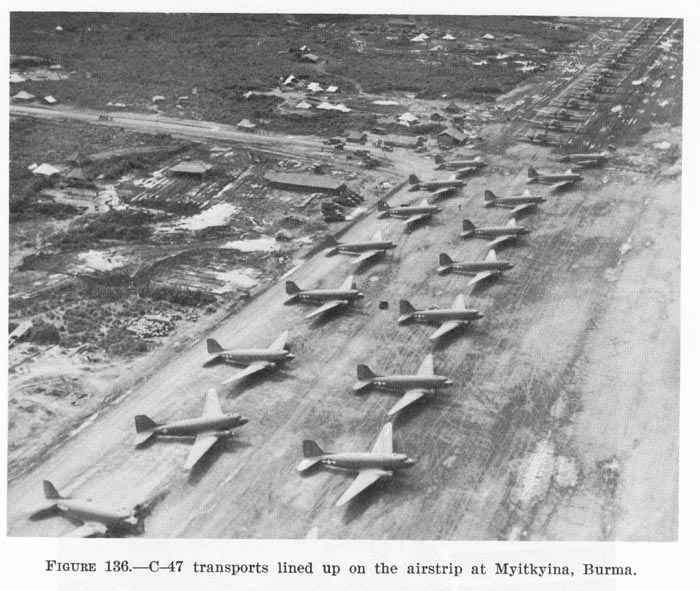
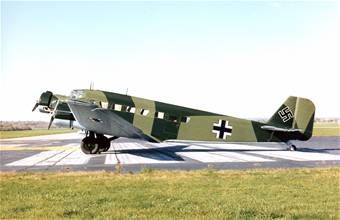
 After World War II, the military sold off thousands of war-surplus C-47 "Gooney Birds". Having survived the harshest possible use, most of these DC-3's were still quite ready for more work. By the thousands, C-47's were repainted in civilian uniforms, and put to work.
After World War II, the military sold off thousands of war-surplus C-47 "Gooney Birds". Having survived the harshest possible use, most of these DC-3's were still quite ready for more work. By the thousands, C-47's were repainted in civilian uniforms, and put to work.

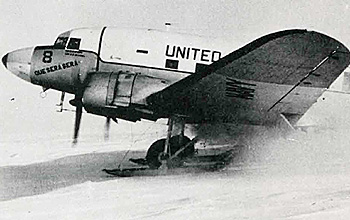


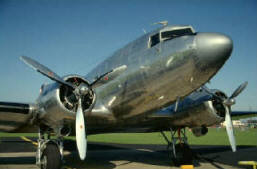 The DC-3 deserves credit for another virtue: it established, firmly, the value of modern aircraft construction: lightweight aluminum, stressed-skin, "semi-monocoque" cylindrical-fuselage construction (as a replacement for boxy, heavy, old-fashioned steel-tube truss construction); and multi-cellular, stressed-skin "fail-safe" wing construction.
The DC-3 deserves credit for another virtue: it established, firmly, the value of modern aircraft construction: lightweight aluminum, stressed-skin, "semi-monocoque" cylindrical-fuselage construction (as a replacement for boxy, heavy, old-fashioned steel-tube truss construction); and multi-cellular, stressed-skin "fail-safe" wing construction.
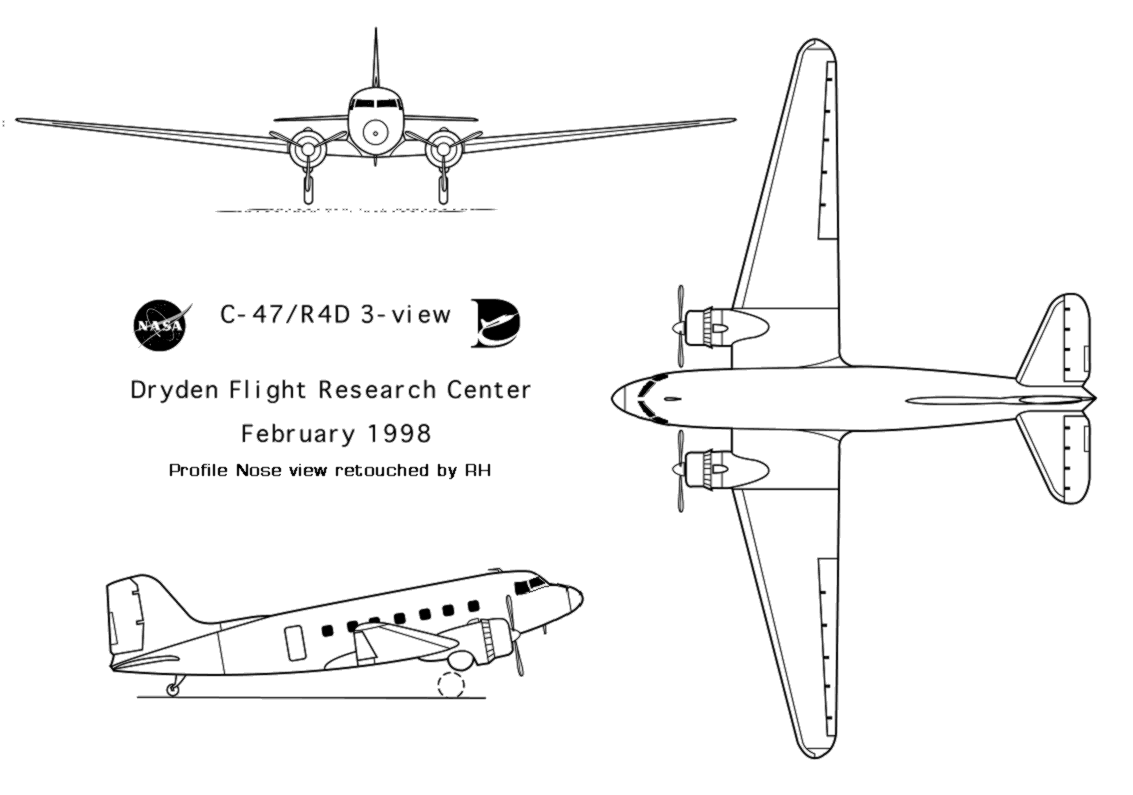

 Future airliners, like the Boeing 307 Stratoliner, Lockheed Constellation (left), and Douglas's own DC-6 and DC-7 -- along with pressurized, tricycle-geared postwar DC-3 imitators (Convair 220 and Martin 2-0-2, most notably) -- would make good use of pressurization in round fuselages.
Future airliners, like the Boeing 307 Stratoliner, Lockheed Constellation (left), and Douglas's own DC-6 and DC-7 -- along with pressurized, tricycle-geared postwar DC-3 imitators (Convair 220 and Martin 2-0-2, most notably) -- would make good use of pressurization in round fuselages.
